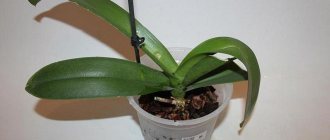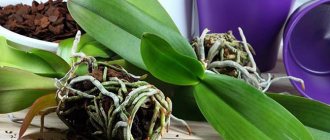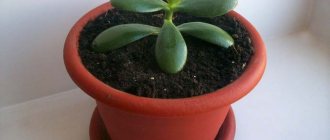Do you have an orchid growing, but you don’t know how to replant it at home? Read the article, it contains a lot of useful tips and instructions.
The orchid, just like the rose, can be called the queen of flowers. Graceful flowers, decorative leaves, intertwining roots and stems create a plant of incredible beauty. But this flower, like all the others, needs good care, an important component of which is replanting. It needs to be done correctly and on time - the further development of the plant and the abundance of flowering, as well as the duration of the adaptation process, depend on this.
Read another article on our website that tells how to propagate an orchid at home with children, cuttings, roots, and seeds. All methods are described in detail.
This article describes the timing, as well as the rules for transplanting a home orchid. You will learn how to replant a flower after the store and why to do it at all. Read on.
Why replant an orchid when grown at home: is it replanted at all, is it possible?
Orchid transplantation at home
Various circumstances may arise under which a transplant is performed. Why replant an orchid when growing it at home? Is it possible to replant at all? Yes, this can and should be done. Here are the circumstances under which flower breeding experts advise doing this:
- Replanting is required once every 3-4 years after purchasing or replanting the plant.
- If it is noticed that the roots have begun to appear from the pot, i.e. it has become too small for the plant.
- If the orchid is very sick, all its leaves begin to turn yellow.
- Unsightly appearance and condition of the substrate in which the flower grows. Mold or severe dryness of the upper fragments has appeared on the surface, which indicates a loss of the filler’s ability to pass water and air.
- The plant does not bloom for several years, and then it needs a good shake-up in the form of a transplant.
- If necessary, divide the orchid.
If these signs are not observed, it is better not to touch the orchid - it does not really like to be disturbed. It is also not recommended to do this during the flowering process; it is better to wait until it is over, unless an urgent transplant is needed.
Timing: when can an orchid be replanted?
Replanting an orchid at home
This operation should be carried out when the dormant period of the inflorescences and the entire plant has ended. But there are types of orchids in which the dormant period is weakly expressed, for example, phalaenopsis, which blooms almost all year round with short breaks. Therefore, if new shoots of a plant do not develop in the absence of signs of disease, it means that it is entering a dormant period. This is the best time to replant. This time usually occurs in the spring - late February and March. This is the best time to replant an orchid.
Lighting for orchids in winter
In winter, daylight hours become shorter; orchids often do not have enough natural light for normal wintering. Therefore, place pots on southern windows. And if this is not possible, take care of installing an additional light source.
From mid-October, orchids already need additional lighting. It is advisable to purchase a special phytolamp. But you can also use a regular lamp with a fluorescent bulb of about 60 watts. Light can be either warm or cold. An additional light source should be placed no further than 20–40 cm from the plant.
Photo: It is advisable to purchase a special phytolamp.
If the plant does not have enough light, it will not be able to set flower buds. With a lack of light, the leaves become stretched and acquire a dull and not very beautiful shade.
The ideal daylight hours for an orchid are from 8 am to 8 pm. Try to create such conditions, and the plant will always have a beautiful color and full of vigor.
Frequency of orchid transplantation at home: how often?
Replanting an orchid at home
Many novice flower lovers ask the question: “How often to replant an orchid?” . What determines the frequency of transplanting inflorescences at home?
- The answer to this question depends on what composition of the substrate is in the container.
- It may consist of moss, and then it needs to be replanted more often - once every two years .
- If the main part of the substrate is bark, which decomposes more slowly, then you can replant it once every three years.
Of course, these dates are indicated for planned replantings, when the inflorescence looks completely healthy and has no signs of damage by insects.
Substrate for orchid transplantation at home: what is it made of?
Substrate for transplanting orchids at home
To transplant orchids at home, you need to choose a high-quality substrate. The health and further flowering process of the plant largely depends on this. What is it made of? You can buy a specialized one at retail outlets, but it comes in two types:
- For epiphytic (i.e. with aerial roots). It's called Phalaenopsis Mixture.
- For terrestrials - “Mixture for Cymbidium”.
The first mixture is used for flowers growing on trees with long aerial roots. Therefore, the substrate for them must be breathable, because the roots of these flowers take part in photosynthesis and they do not need soil, only moisture, to grow. The composition of such mixtures usually includes:
- Pine bark
- Ground fern root
- Activated carbon
- Cut cork
- Sphagnum in small quantities
The second type of mixture is denser, because it is intended for orchids living on the ground. It contains more of these ingredients:
- Sphagnum moss
- Lowland peat
- Leaf ground
- Coal
Sometimes various synthetic materials, such as perlite or foam, are used as a substrate. You can also use:
- Expanded clay
- Shell rock
- Pumice
The substrate can be made at home. Pine bark is used for this:
- First disinfect it - hold it over steam for half an hour or boil it in water.
- After this, dry and boil again. This treatment kills all pathogenic organisms.
- Place to dry again and then cut into pieces up to 2 cm .
To the bark prepared in this way, add dry and finely chopped sphagnum moss and just a little peat coal. You can now fill the pots with this mixture.
Preparing the pot
Moving on to the story of how to replant a new orchid, it is worth telling in detail about preparing the pot for the new flower. The choice of container and soil is described in detail above.
Taking the selected pot, fill it one third with drainage. It is advisable to use natural materials that do not absorb water. For example, smooth and small pebbles. You need to pour the prepared substrate over the drainage - a layer of about three to five centimeters is enough. Then there will be quite a lot of free space left to the edge of the pot - at least seven to nine centimeters.
Which pot is best to replant a home orchid?
It is better to replant the orchid in a transparent pot.
Most orchids have large roots that like to entwine the pot from the inside and even look out. Therefore, when choosing a new container for a flower, you need to focus primarily on the size of the root system. But, given that the base of the flower will grow further, you need to add a few centimeters to the diameter. Which pot is best to replant a home orchid?
Worth knowing: For a large orchid with intensive growth, you can buy a pot, as they say, “for growth,” so as not to replant it often.
Orchid lovers most often grow their “beauties” in plastic transparent pots or containers. What are the advantages of such containers? Here is the answer:
- The roots are clearly visible and you can constantly monitor their condition. With normal soil moisture, the roots are usually green, but as the substrate dries, they gradually turn gray, which indicates the need for watering.
- In plastic containers, unlike clay ones, the roots do not grow to the walls of the container and therefore are not injured during replanting.
Although clay containers have their advantages:
- In them, the base-root does not overheat, which is very important for orchids.
- Do not overwater the plant because the moisture will last longer.
- In addition, a clay pot is much heavier than a plastic one and therefore will not tip over. Orchids are planted in such pots, some of the roots of which completely dry out and die during the dormant period.
Be sure to make drainage holes in the containers. This will provide the roots with faster drying and ventilation, which will protect them from rotting. Flower lovers with no experience often overwater the plant for fear of drying it out. Drainage holes will help in this case too.
Worth knowing: Plastic containers have one drawback - they have a rather simple, not very sophisticated appearance, compared to the flower itself. To correct this shortcoming, you can buy a beautiful flowerpot that will completely hide the plastic.
There is another way out - you can put a plastic pot in a low glass vase. The space between the walls of the vase and the pot is filled with some kind of jewelry or tinsel, balls or floral fillers. This needs to be done carefully so that the multi-colored filler does not distract from the beauty of the orchid flowers.
Remember: Do not buy large containers for orchids. In small ones - up to 15 cm in diameter, it feels much better and blooms longer.
How to transplant children, one child, a shoot of a home orchid: step-by-step instructions
Replanting a baby home orchid
An orchid growing in normal, ideal conditions can produce young shoots, or babies. This is a great opportunity to propagate the plant. What should be done? How to transplant children, one child, a shoot of a home orchid? Here are the instructions step by step:
- The baby should have fairly long roots - more than 5 cm and 3-4 leaves - these are the most suitable parameters for transplantation.
- Children usually appear on the stem or near the root collar. Using a sharp knife, you need to cut off part of the stem with the baby, stepping back to the sides at a distance of about 1 cm . Sprinkle the cut area with coal.
- Prepare a small glass in advance, preferably a plastic one, and add a small layer of drainage.
- Place the baby in a glass and carefully cover it with substrate. for the first 3-4 days .
- Place the glass with the baby in a place where the air humidity is high. You can simply spray the surface of the window sill where the glass is located more often. Try not to get it on the leaves.
The baby will grow in such a container for about a year, after which it can be transplanted into a larger container. An orchid grown from a child will bloom in three years .
Room ventilation and drafts
All plants, like humans, need fresh air to be healthy. Do not forget to periodically ventilate the room where orchids grow. Try to keep the flower away from cold air streams and do not create drafts with winter air. Lightly freshen the air in the room, just like for yourself.
Cold air can quickly destroy the leaves of a plant. To prevent this from happening, when airing, the flower pot can be removed from the windowsill to the back of the room.
Make sure that the leaves do not touch the cold glass of the window.
Photo: Make sure that the leaves do not touch the cold glass of the window.
In severe frosts, it is best to remove the orchid from the windowsill or install a protective foam barrier around the plant.
Further proper care of the phalaenopsis orchid plant after transplantation, growing conditions
After replanting, you need to provide proper and timely further care for the orchid. Here are the conditions for growing a phalaenopsis orchid plant:
Proper care of an orchid is to shade the window so that the sun does not burn the leaves of the flower.
- As mentioned above, immediately after the transplantation is made, the container is placed on a sunny windowsill for a week, but shaded from direct sunlight. Otherwise, if this is not done, the orchid leaves will lose their decorative appearance, wrinkle and become wilted.
You can water the flower after transplanting only after a couple of weeks.
- water the plant after replanting only after 2 weeks . The fact is that orchid roots are susceptible to various fungal diseases. Therefore, the root system needs to be slightly dried to avoid this. Find out how to properly water an orchid here .
Spraying the plant so as not to dry it out
- But, in order not to dry out the plant, spray the leaves, or, even better, wipe them with a wet sponge. In this case, under no circumstances should water get into the depths of the rosette of leaves. This can lead to their rotting.
Orchid grows at optimal temperature
- It is important to maintain optimal temperature. The orchid does not like heat, it needs a temperature no higher than +21-22°C , but it should not fall below 18°C . Otherwise, the inflorescences get stressed, which is very undesirable for these sissies.
Feed the orchid
- A blooming orchid needs feeding. Use only mineral mixtures. Organic ones are not suitable for feeding flowers, since they can introduce diseases into the soil.
Excessive nitrogen nutrition can cause leaf growth to the detriment of flowering. Nowadays you can find special fertilizer compounds for orchids in stores. In any case, it will be good to use an all-purpose fertilizer for flowering plants. They must be diluted strictly according to the instructions so as not to harm the flower. They need to be added along with water for irrigation.
When can I plant a small plant?
When can I plant a small plant? Several babies can be formed from one maternal specimen. First they will develop leaves, and eventually roots. If the root system does not develop, it can be stimulated. What is needed for this? Prepare cling film, sphagnum moss and strong thread. Next you need to proceed like this:
- Soak the moss in water. It should swell well.
- Roll a ball of moss and wrap it with thread. This will prevent disintegration.
- Next, attach the lump to the peduncle with a thread, but act carefully so as not to injure the plant.
- If necessary (if the room has low humidity), wrap the moss with cling film to ensure the creation of a greenhouse effect inside. But keep in mind that the film will need to be opened daily so that the baby can breathe.
- It is advisable to attach a support to the peduncle with moss. This is necessary to ensure that the plant does not tip over.
- Spray the moss with water every day. You can use Kornevin for spraying (a means for stimulating root growth), which is diluted with liquid according to the instructions on the package.
Now all that remains is to wait for the roots to form. This may take up to six months. Remember that you can separate the baby from the mother specimen only if it has formed 3-4 roots 5 centimeters long. If this does not happen, there is a high probability that the plant will not take root well in a separate pot and may even get sick. It's better to wait a little for the roots to grow.
If there is no flowering after transplantation: what to do?
Lack of flowering after transplantation
After transplantation, the orchid should increase its green mass and bloom after a certain time. This usually happens after 3-4 months . But what if the inflorescences do not appear for much longer? What to do if there is no flowering after transplantation? This problem can occur for several reasons:
- The plant is overfed with nitrogen fertilizers , active leaf growth is observed, they become larger than they should be during normal development. In this case, feeding should be stopped for a month.
- The transplant was not carried out in a timely manner . For example, if for some reason an orchid was transplanted at the time when it bloomed last year, then it most likely will not bloom this year. The plant will direct all its energy to restoring its root system, and not to flowering.
- Perhaps you made mistakes during transplantation . If the plant is not firmly fixed in the substrate, then when you move the pot, it begins to dangle in it, and the roots and stems will receive microtrauma. The plant does not have the opportunity to direct its energy to flowering, experiencing constant stress.
- Insufficient lighting and low humidity . You need to move the pot to a lighter windowsill and spray its surface to increase the humidity of the surrounding air.
Follow these tips, and your flower will soon delight you with its unique blooms. It's worse when the plant begins to wilt. What to do? Read on.
Spring care
Spring is a period in the life of orchids during which these plants need help preparing for summer. In addition, in spring it is best to carry out the breeding procedure.
| Month | Rules of care |
| March | For most orchid species, March is considered the period when intensive growth begins. Therefore, this month it is already possible to transfer the flowers to the “summer” mode of maintenance: water and feed more often, and also increase the temperature at night by several degrees. And although the orchids have finally woken up, over the winter they have become quite unaccustomed to the bright sun. Therefore, they need to be accustomed to spring sunbathing gradually to prevent leaf burns. To do this, the flowers need to be shaded. Along with orchids, pests also become active in the spring. Therefore, plants need to be periodically inspected, and increased attention should be paid to preventive treatments. If you are waiting for the moment to propagate your orchid, then March is the best time for this. This month, orchids most easily tolerate reproduction by division. Orchids that are supposed to bloom in March should not be fed with nitrogen-based fertilizers: this will encourage the plant to actively grow green mass, and it may “overshoot” the flowering stage. |
| April | Almost all types of orchids are already in a period of active growth in April, many of them bloom. However, bright sunshine should still be avoided. But from April you can start spraying orchids regularly. This should be done with warm water and in the first half of the day. In April, you can change the place where you keep your orchids. And although it is believed that it is better not to disturb these delicate plants again, because they do not really like changing their place of residence, they should still be moved to a new place 1-2 times a year. At the same time, new shoots can be planted. But keep in mind that in size they should be 1/4 of last year's. |
| May | In May, as a rule, the care regimen is not significantly different from April. At the end of the month, when the weather is good, the orchids can be exposed to fresh air: taken to the terrace or balcony. However, it is worth remembering that not all orchids will be delighted with “walks”: there are some species for which street keeping is contraindicated. This applies to bulbophyllum, dendrobium, doritis, aerangis and some types of paphiopedilum and phalaenopsis. |
What to do if your home orchid withers after transplantation?
A home orchid withers after transplantation.
Most likely the plant is sick. If planting rules are violated, when mechanical damage to the roots occurs, the leaves do not receive full nutrition. What to do if your home orchid withers after transplantation? Here are the tips:
If you watered a lot, replant the plant:
- With good watering and stagnation of liquid at the bottom of the container, especially if there is no drainage, the roots may begin to rot.
- Then the wilting will soon be replaced by yellowing of the leaves and the plant may die.
- Here an emergency orchid transplant will be needed to save it.
Control pests:
- Another reason could be a pest attack.
- Spider mites, the worst pests of indoor plants, thrive in dry air.
- It can be difficult to notice them right away - they are very small and the bad effects begin to appear when there are a lot of them.
- Whiteflies and scale insects also harm orchids. Providing optimal air humidity will help to significantly reduce the number of these insects.
Protect from the sun:
- If the orchid is not protected from direct sunlight, its leaves will begin to wilt.
- This indoor flower feels best on windows that face east, where the sun appears only in the morning and for a short time.
Containers must be provided with drainage holes, and they need to be made not only at the very bottom of the container, but also on the sides to ensure good air exchange for the roots.
Why is it important to separate the child from the parent?
A baby is a young plant that has grown on a stem. It may appear on the peduncle, trunk or roots. In most cases, young shoots grow on the peduncle. First, a compaction appears, then a bud forms, and after that a young shoot grows from it. Sometimes a daughter shoot may have its own roots, stem, or peduncle. Occasionally it happens that it blooms directly on the mother plant.
Orchid with young shoot
It is necessary to separate the baby from the mother orchid so that the parent does not die. The daughter shoot takes a lot of nutrients, so the mother plant receives them in insufficient quantities, which is why it may get sick and not survive. There are difficult situations when either a daughter or a parent can die. In this case, they need to be planted urgently.
Attention! If the baby grew up on the stem of an orchid, then under no circumstances should it be separated from the mother flower. It feeds from a common root through the stem, so it will not survive on its own.
Daughter shoot on a peduncle
How to properly water a home orchid flower?
Well-groomed orchid flowers
Watering a home orchid flower is carried out by immersion in water, the temperature of which is not lower than +20°C , so as not to cause stress to the plant. How to do this correctly? Here is the answer:
- To do this, take a cup with warm liquid and place the container with the plant in it for 20 minutes .
- Then take it out and place it on a wire rack to drain off excess water.
- Then place the flower in its usual place.
In winter, the number of waterings should be reduced, but in summer, on the contrary, this should be done more often, at least twice a week. It is necessary to monitor the pseudobulb - if it has lost turgor, then watering is necessary.
Important: It is forbidden to take long breaks between waterings. The orchid is a tropical plant that naturally lives in times of frequent rain and high humidity. Therefore, drought is detrimental to it.
Temperature for orchids in winter
The most optimal daytime temperature for orchids is considered to be +21… +24 degrees. At night it should drop slightly, but not below + 15 degrees. Temperature changes of 5-7 degrees are closest to natural. They stimulate the plant to lay flower buds.
Photo: Temperature changes of 5-7 degrees stimulate the plant to bud.
This is exactly what happens in my house. And now my phalaenopsis orchid stands with small buds.
Therefore, if you want your plant to bloom, do not create greenhouse conditions for it in winter. You can safely open the window at night and thereby lower the night temperature in the room. The plant will quickly respond to this and will soon bloom.
How to replant an orchid flower if the root is rotten: tips
Replanting an orchid flower if the root has rotted
Infrequently, but there are cases when novice gardeners, as a result of improper care, have the roots of an orchid rot. This can happen to all the roots or to a large part of them at once. Is it possible to save the plant then? How to replant an orchid flower if the root is rotten? Here are the tips:
- To revive orchids whose roots have completely died, you need a small window greenhouse.
- In the container where the leaf rosette will be located, you need to pour a small layer of drainage - this can be expanded clay or pebbles.
- Place sphagnum moss on top, which is previously kept over steam and dried.
- Now moisten the substrate and place the leaf rosette in it.
- Transfer to a greenhouse, where a constant temperature should be maintained within +21 - +27°C and high humidity of about 100% . The light should be bright, but diffused - direct sunlight is detrimental to leaves during this period.
After 3-4 weeks of this regime, root rudiments will begin to appear at the base of the leaf rosette and then they will begin to grow. Epin , to the water for irrigation .
If a diseased orchid has several living roots left, or even just one, the chances of saving it increase:
- After trimming the rotten roots, you need to rinse the remaining living roots under warm water and sprinkle the cut areas with charcoal.
- A pre-prepared pot up to 8 cm in diameter is filled with ordinary substrate and a leaf rosette with roots is planted in it.
- Next, the plant is treated as in the first case, placing it in a greenhouse.
If everything went well, new roots will begin to grow in 2-4 weeks .
What to do with an orchid peduncle. Trimming
One of the main questions is “What to do with the arrow when the orchid has faded?”
Some novice gardeners cut off the peduncle immediately after flowering. So they are trying to stimulate faster growth of new leaves and arrows. I would like to point out right away that this is wrong.
After flowering, it is better to leave the shoot; this is done for the following reasons:
- if the peduncle dries out, do not rush to cut it, throughout the entire time the flower will additionally receive from it the nutrients that it has accumulated;
- if the arrow remains alive and green for six months, then from its dormant buds, by stimulation, you can get either flowers or a baby for reproduction.
But the peduncle will still have to be shortened a little; after 1-2 weeks it is worth cutting off its upper part above the third dormant point. The cut is immediately processed and allowed to dry.
Important! During this period, you should refrain from spraying the plant.
Full pruning is carried out when the shoot has completely dried out and turned yellow-brown. At the same time, 2-3 cm are retreated from the trunk of the plant so as not to accidentally damage it.
To stimulate the orchid to reproduce, it is better to trim the peduncle in the summer. It is in the warm season, with the proper level of humidity, that orchids are most willing to produce babies.
Is it possible to replant a flowering orchid while it is blooming?
You can replant orchids during flowering, but in the most urgent cases.
There is only one situation in which you can replant a blooming orchid - if it is in danger of dying for any reason and you need to choose one of two:
- The orchid will fade, but then die, having spent its last energy on flowering.
- The peduncle is cut short, but later with good care, the plant is completely restored and after a while it will bloom again.
What to do in the second case? Adviсe:
- Prepare fresh substrate and pot. How to do this has already been said above in the text.
- Cut the flower stalks of the orchid to about 2/3 of the length. By the way, the flowers can be placed in water - they will last for almost a week.
- Carefully remove the plant from the pot and inspect the roots, cutting out any rotten ones.
- If the substrate is in normal condition, i.e. there is no mold or its smell, it is not overdried or, on the contrary, very waterlogged, then in this case you need to try to preserve it as much as possible without shaking off the roots. Otherwise, proceed as with a regular transplant, the procedure of which has already been described.
- Now you need to place the plant in the pot and secure it well there.
All that remains is to put the orchid, transplanted during flowering, into the greenhouse and observe how it will feel further. Do not forget to follow all the rules for caring for this flower, which are no more complicated than the rules for caring for other indoor flowers.
Periods during which the procedure is prohibited
You should not replant flowering phalaenopsis; they may drop their flowers due to stress. Only in extreme cases, such as an overgrown root system or an accidental fall, can the orchid be replanted despite flowering.
Do not forget about possible diseases, which also allow you to replant during flowering, since the health of the plant is more important than anything else.











